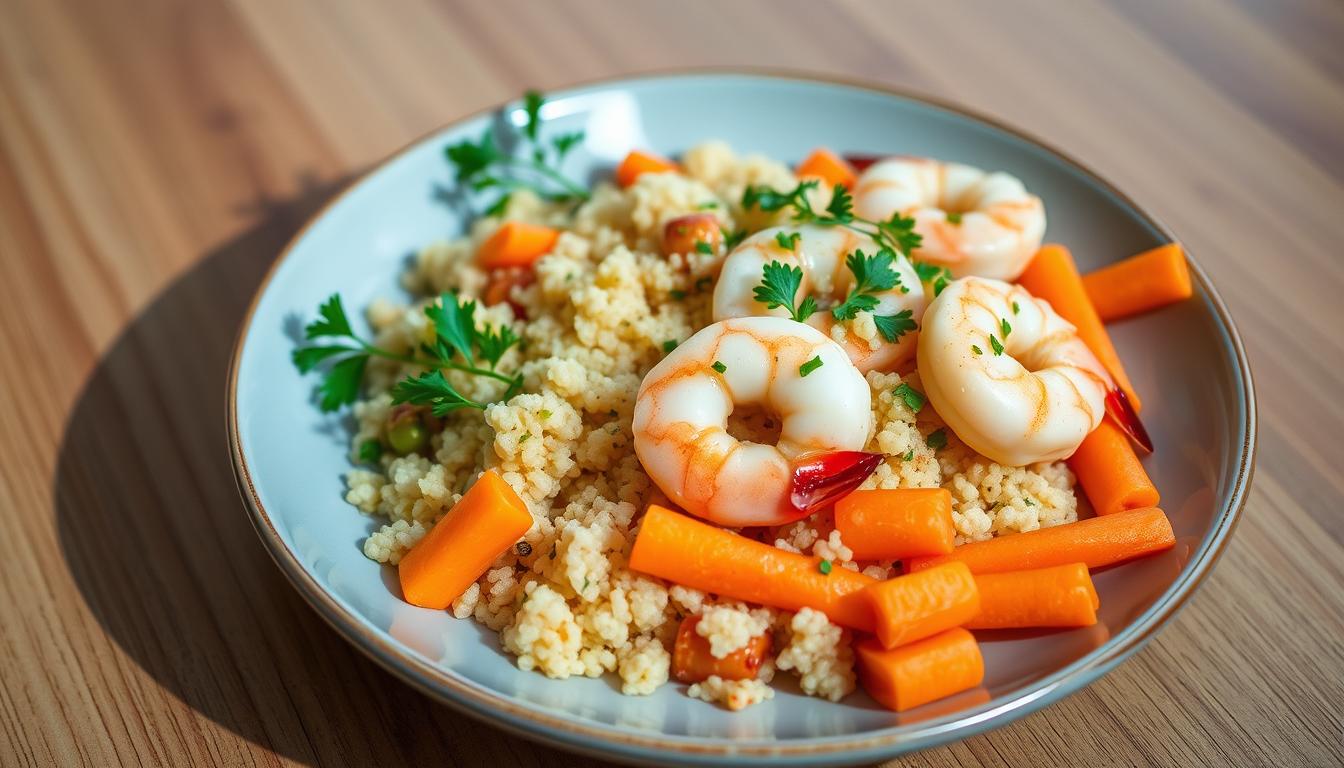Could a low FODMAP diet help manage your endometriosis symptoms? Studies show that up to 30% of people with Hashimoto’s thyroiditis feel better after trying this diet. With 10-20% of the world’s population dealing with irritable bowel syndrome (IBS), a diet low in FODMAPs might offer significant relief.
In this article, we’ll look at a tasty and healthy shrimp quinoa carrots dish. It fits well with a low FODMAP diet. This recipe is packed with anti-inflammatory ingredients and is rich in fiber, making it a great choice for managing endometriosis.
Introducing the Endo-Friendly Shrimp Quinoa Carrots Dish
A Delicious and Nutritious Meal for Endometriosis Management
Living with endometriosis can make finding good meals tough. But, we’ve got a great solution – the endo-friendly shrimp quinoa carrots dish! It’s packed with lean shrimp, superfood quinoa, and anti-inflammatory carrots. This mix helps manage endometriosis symptoms.
This dish is low in FODMAPs, making it perfect for those on a FODMAP diet. It’s designed to avoid triggers and includes ingredients that fight inflammation. So, it’s not just tasty but also meets the dietary needs of those with endometriosis.
Ready to explore a meal that’s good for your body and helps with endometriosis symptoms? Let’s look closer at the endo-friendly shrimp quinoa carrots dish. It’s a great addition to your diet for managing endometriosis.
The Importance of a Low FODMAP Diet for Endometriosis
Living with endometriosis can really affect our health and happiness. A low FODMAP diet is a helpful way to manage symptoms. FODMAPs are hard for some to digest, causing digestive problems and other issues.
Following a low FODMAP diet can help reduce inflammation and improve gut health. This can ease symptoms like bloating, pain, and digestive issues. It also helps with hormonal imbalances, aiding in endometriosis management.
Some key benefits of a low FODMAP diet for endometriosis include:
- Improved digestive health and reduced gastrointestinal symptoms
- Reduced inflammation and pain associated with endometriosis
- Better management of hormonal imbalances
- Increased overall well-being and quality of life
By eating gut-friendly foods and avoiding high FODMAPs, we can manage our endometriosis better. To learn more about the low FODMAP diet and its benefits for endometriosis, we encourage you to explore the resources available.
Quinoa: A Nutrient-Dense Superfood
Quinoa is a favorite gluten-free grain for those with endometriosis. It’s packed with health benefits, making it great for an endometriosis-friendly diet.
Exploring the Benefits of this Gluten-Free Grain
Quinoa is a complete protein, meaning it has all nine essential amino acids. This is great for endometriosis nutrition, helping the body grow strong. It’s also full of dietary fiber, which is good for digestion and gut health.
Quinoa is also rich in essential minerals like iron, magnesium, and zinc. These minerals are key for good health, which is important for those with endometriosis.
Quinoa is easy to use as a gluten-free grain. It tastes nutty and is fluffy, perfect for many meals. Adding quinoa health benefits to your diet can help manage endometriosis.
Looking for new whole grains or nutrient-dense foods for endometriosis? Quinoa is a top choice. Its great nutrition and versatility make it a must-have in any endometriosis-friendly kitchen.
Shrimp: A Lean Protein Source for Endometriosis
If you’re dealing with endometriosis, adding shrimp to your diet can make a big difference. Shrimp is a lean protein that brings many benefits for those with this chronic condition.
Shrimp is low in calories and fat but packed with protein. This makes it a great choice for the endometriosis diet. Research shows that eating shrimp for endometriosis can help because it has anti-inflammatory properties.
Shrimp is not just a lean protein source. It’s also full of seafood nutrition. It has important vitamins and minerals like vitamin B12, zinc, and selenium. These nutrients help keep your body healthy and fight inflammation.
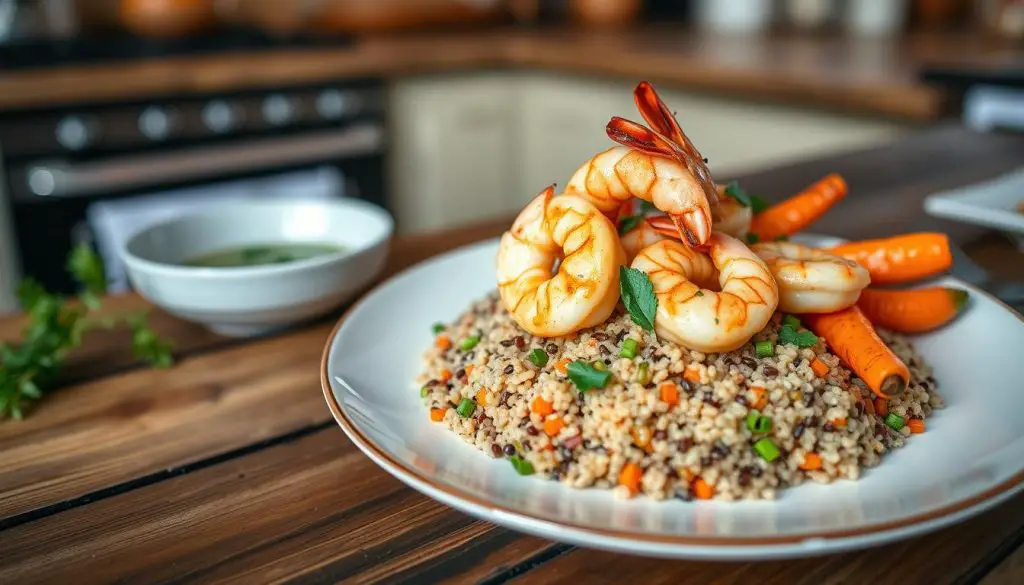
Eating anti-inflammatory foods like shrimp can help manage endometriosis. Choosing nutrient-rich, whole foods nourishes your body. This can help reduce some of the pain and discomfort from endometriosis.
Remember, finding the right balance in nutrition is important for managing endometriosis. Always talk to a healthcare professional or a registered dietitian. They can help create a diet plan that fits your needs and tastes.
Endo friendly shrimp quinoa carrots
For those with endometriosis, a balanced diet is key. Our endo-friendly shrimp quinoa carrots dish is a tasty, healthy meal. It helps ease the symptoms of this chronic condition.
This recipe is great for those on a FODMAP diet. It includes shrimp, quinoa, and carrots. These foods are low in FODMAPs. Quinoa is packed with nutrients and is gluten-free. Shrimp is a lean protein with omega-3s, and carrots are full of antioxidants.
| Ingredient | Nutrient Profile |
|---|---|
| Shrimp | Lean protein, anti-inflammatory omega-3s |
| Quinoa | Gluten-free, complex carbs, protein, fiber |
| Carrots | Antioxidants, carotenoids, anti-inflammatory |
Adding this endo friendly shrimp quinoa carrots dish to your meals can be beneficial. It’s a balanced, nutrient-rich option. It may help manage endometriosis symptoms. Try it with other low FODMAP recipes and endometriosis-friendly meals for better health.
Preparing the Perfect Shrimp Quinoa Carrots Bowl
Get ready to make a tasty shrimp quinoa carrots recipe. It’s healthy and full of flavor! Follow this easy guide to make a meal that looks great and tastes amazing. It’s perfect for those on a low FODMAP diet or managing endometriosis.
Cooking the Quinoa
Rinse the quinoa to get rid of any bitterness. Mix it with water or low-sodium broth in a saucepan. Bring it to a boil, cover, and lower the heat to low.
Simmer for 15-20 minutes until the quinoa is soft and the liquid is gone. Fluff it with a fork and set it aside.
Sautéing the Shrimp
Heat some olive oil in a big skillet over medium-high. Add the shrimp and cook for 2-3 minutes on each side. They should be white and cooked through.
Season the shrimp with garlic powder, paprika, and salt and pepper to taste.
Roasting the Carrots
Preheat your oven to 400°F (200°C). Toss the carrot slices with olive oil, dried thyme, and salt and pepper. Spread them on a baking sheet.
Roast for 20-25 minutes until they’re tender and a bit caramelized.
Now, it’s time to put your shrimp quinoa carrots bowl together. Start with quinoa, then add the shrimp and carrots. Top it with fresh parsley or cilantro for extra flavor.
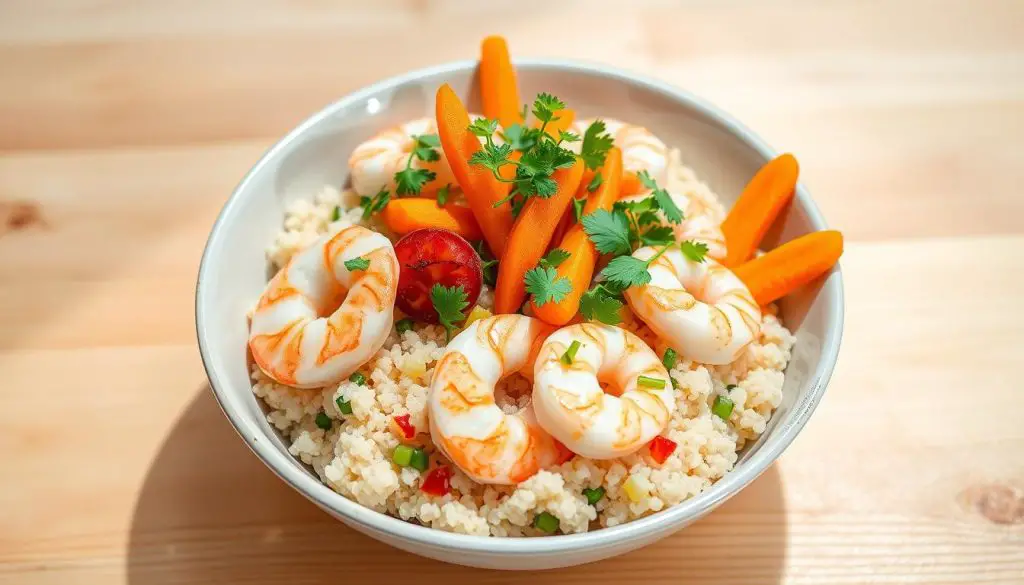
Congratulations! You’ve made a delicious and healthy low FODMAP meal. It’s great for managing endometriosis. Enjoy this tasty shrimp quinoa carrots recipe as part of your meal prep or as a quick, easy dinner.
The Health Benefits of Carrots
Carrots are a key ingredient in our tasty shrimp quinoa carrots dish. They bring many health benefits, which are great for people with endometriosis. These anti-inflammatory vegetables are also fiber-rich and nutrient-dense, supporting overall health.
Carrots are packed with vitamins, minerals, and antioxidants. They contain beta-carotene, vitamin A, and vitamin C. These nutrients fight inflammation, a big issue for those with endometriosis. Eating endometriosis nutrition like carrots can help manage symptoms.
Carrots are also good for your digestion because of their fiber. This can help with stomach problems that come with endometriosis. Plus, their fiber makes you feel full longer, helping with diet and weight control.
| Nutrient | Amount per 1 cup raw carrots |
|---|---|
| Calories | 50 |
| Carbohydrates | 12g |
| Fiber | 3g |
| Vitamin A | 428% of the Daily Value |
| Vitamin C | 6% of the Daily Value |
| Potassium | 6% of the Daily Value |
Adding these nutrient-dense ingredients to your diet can boost your health. It helps manage endometriosis challenges.
Maximizing Flavor with Herbs and Spices
Creating a tasty shrimp quinoa carrots dish starts with herbs and spices. They add depth and complexity. They also offer anti-inflammatory benefits, great for those with endometriosis.
Enhancing Your Dish with Natural Ingredients
Begin with garlic, which adds a savory taste and fights inflammation. A squeeze of fresh lemon juice brightens the flavors. Herbs like parsley, basil, or cilantro add a vibrant touch.
If you’re on a low FODMAP diet, choose wisely. Ginger, turmeric, paprika, and dried oregano are good options. They make your meal flavorful without upsetting your stomach.
Using these herbs and spices, you can make your shrimp quinoa carrots both nourishing and tasty. It’s perfect for those with endometriosis.
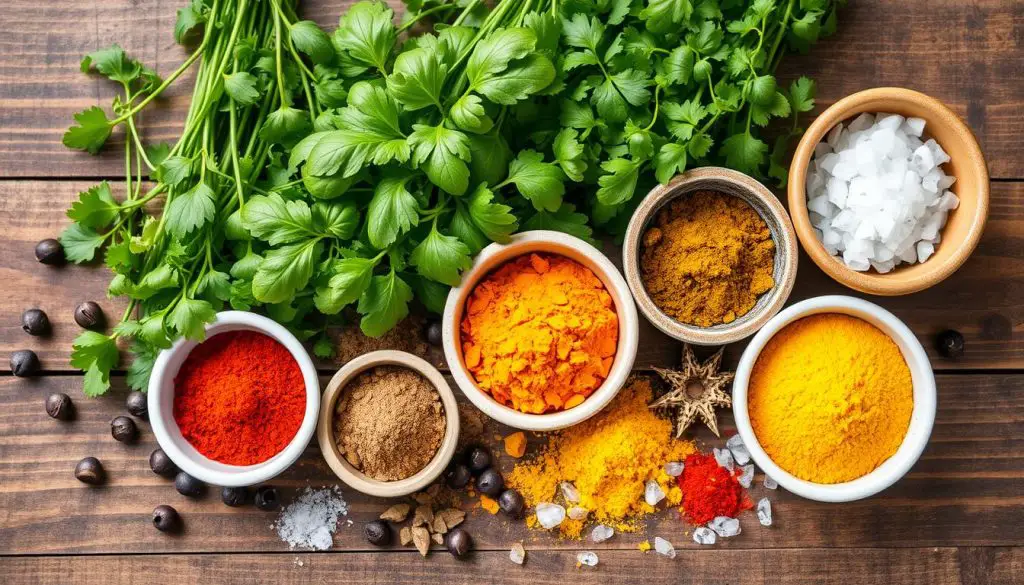
Tips for Meal Prepping and Storing Leftovers
Keeping a steady diet is important for managing endometriosis. One good way is to get into meal prepping and storing leftovers right. This way, you can always have healthy, low FODMAP foods like our tasty Shrimp Quinoa Carrots ready.
Start your meal prep endometriosis journey by setting aside a few hours on the weekend. Cook the quinoa, sauté the shrimp, and roast the carrots ahead of time. This makes it easy to put the whole dish together during the week. It saves time and keeps your meals low FODMAP food storage friendly.
- Cook the quinoa in advance and store it in an airtight container in the refrigerator for up to 5 days.
- Sauté the shrimp and store it in a separate airtight container, also in the fridge for up to 3 days.
- Roast the carrots ahead of time and keep them in a sealed container for up to 1 week.
For leftovers storage, divide the Shrimp Quinoa Carrots into individual servings. Store them in the fridge for up to 3 days. To reheat, just put the portion in a microwave-safe dish and heat until hot. This keeps the dish shrimp quinoa carrots meal planning friendly.
Using these meal prep endometriosis and leftovers storage tips, you can enjoy the Shrimp Quinoa Carrots all week. You won’t have to give up taste or stick to your low FODMAP diet. Enjoy your meals!
Variations and Customizations
The shrimp quinoa carrots dish is incredibly versatile. You can easily change it to fit your taste and dietary needs. Whether you have endometriosis or want to eat more low FODMAP foods, there are countless ways to customize it.
Endometriosis-Friendly Recipe Modifications
For those with endometriosis, you can make the dish even better. Try using tofu or tempeh instead of shrimp to cut down on animal proteins. This can help reduce inflammation. You can also use different carrots, like rainbow or purple ones, to make the dish more colorful and nutritious.
Personalizing Your Meal
Feel free to change the ingredients to fit your dietary needs. You might choose brown rice or millet instead of quinoa. Adding spinach or bell peppers can also boost the dish’s fiber and nutrients. The goal is to make it taste great and meet your dietary requirements.
Low FODMAP Customizations
For a low FODMAP diet, be careful with your ingredients. Swap out onions and garlic for low FODMAP options. Adding ginger, turmeric, or basil can add flavor without upsetting your stomach.
This recipe is perfect for making it your own. By exploring shrimp quinoa carrots variations, you can make a meal that’s both endometriosis-friendly and low FODMAP customized. It will nourish your body and soul.
Incorporating More Low FODMAP Foods into Your Diet
Managing endometriosis can be a challenge, but adding low FODMAP foods to your diet can help. These foods are good for your gut and provide important nutrients. Let’s look at ways to add more low FODMAP foods to your meals.
Start by slowly adding new low FODMAP ingredients to your meals. Replace high FODMAP foods with low FODMAP ones. For instance, use lactose-free dairy, gluten-free grains like quinoa, and veggies like carrots, spinach, and bell peppers. As you get used to it, you can try more low FODMAP foods.
- Try different low FODMAP fruits like blueberries, oranges, and strawberries. They add sweetness and fiber to your meals.
- Choose lean proteins like shrimp, chicken, and tofu. They are good for you and help manage endometriosis.
- Use low FODMAP herbs and spices like basil, rosemary, and ginger. They make your food taste great without causing symptoms.
A varied low FODMAP diet is important for your health. By trying more low FODMAP foods, you can make tasty, healthy meals that support your health.
Talk to a registered dietitian (RD) who knows about endometriosis. They can help you make a meal plan that fits your needs. You can find new recipes and ways to make your diet better together.
Success Stories: Testimonials from Endo Warriors
Living with endometriosis can be tough, but hearing about others’ success is uplifting. We’ve gathered stories from endo warriors who’ve seen improvement through diet changes. They’ve adopted a low FODMAP lifestyle and added the shrimp quinoa carrots recipe to their meals. Their experiences offer hope and support to those looking to manage their symptoms through food.
“Years of dealing with severe cramps and bloating were tough. But a low FODMAP diet changed everything. The shrimp quinoa carrots dish is now a favorite. It’s tasty, full of nutrients, and gentle on my stomach. My symptoms have lessened, and I feel much better overall.” – Emily, Endo Warrior
“I’ve tried many treatments, but a low FODMAP diet and the shrimp quinoa carrots recipe have made a big difference. The ingredients are anti-inflammatory, and the nutrition is balanced. I feel in control of my body and my condition. I’m thankful for a way to nourish myself while managing my symptoms.” – Jessica, Endo Warrior
- “The shrimp quinoa carrots dish is a weekly staple for me. It’s filling, nutritious, and keeps my symptoms in check. I recommend it to anyone looking to manage their endometriosis through diet.” – Sarah, Endo Warrior
- “After trying many things, I’m convinced that a low FODMAP lifestyle and the shrimp quinoa carrots recipe are key to managing my endometriosis. I’m healthier, more energetic, and in sync with my body.” – Alex, Endo Warrior
These stories show the impact of diet on managing endometriosis. By following a low FODMAP diet and enjoying recipes like shrimp quinoa carrots, these warriors have found relief. Their experiences motivate us to keep exploring how food can help us manage our endometriosis better.
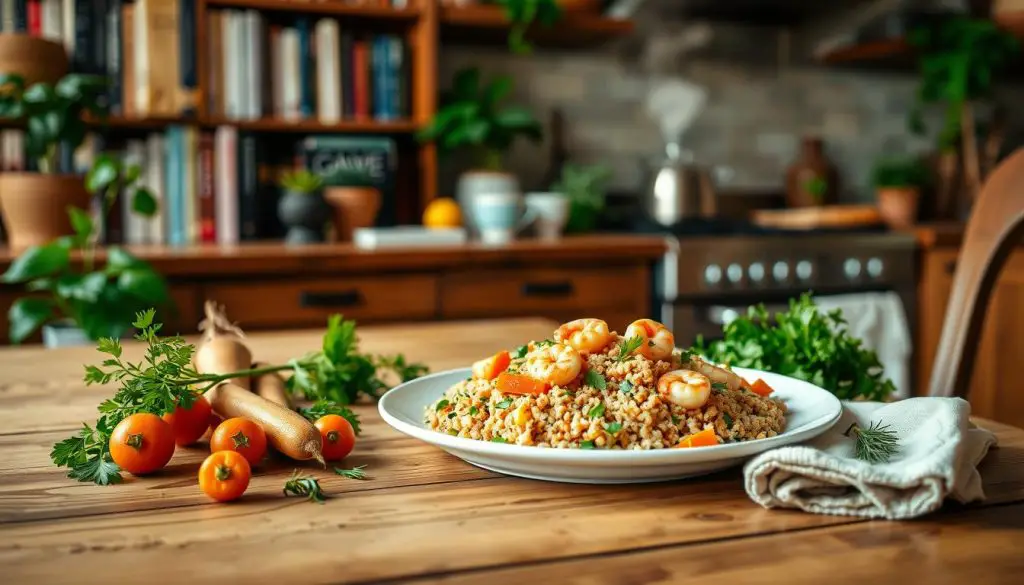
Resources for Further Learning
Exploring a low FODMAP diet for endometriosis can seem daunting. But don’t worry, we’re here to help. We’ve gathered a list of useful resources to help you learn more about endometriosis-friendly foods. This will support your journey towards better health.
Looking for endometriosis diet resources? Check out the Endometriosis Foundation of America and the Endometriosis Association websites. They have lots of info, including low FODMAP recipes and guides. They also offer educational materials to help endo warriors.
We also suggest looking at social media like Instagram and Facebook. There, you can connect with others who manage endometriosis through diet and lifestyle. This community offers inspiration, tips, and support for your journey.
Source Links
- https://www.ibsdiets.org/fodmap-diet/fodmap-food-list/
- https://www.verywellhealth.com/endometriosis-diet-7105372
- https://thyroidpharmacist.com/articles/low-fodmap-diet-sibo-ibs-hashimotos/
- https://www.usenourish.com/blog/4-week-gut-protocol-meal-plan
- https://www.ssmhealth.com/SSMHealth/media/Documents/slucare/services/obstetrics-gynecology-womens-health/endometriosis-diet-booklet.pdf
- https://thedietologist.com.au/what-is-the-best-diet-for-adenomyosis/
- https://sofreshnsogreen.com/recipes/endometriosis-diet-recipes/
- https://www.usenourish.com/blog/7-day-meal-plan-for-crohns-disease
- https://www.everydayhealth.com/diet-nutrition/whole-foods-diet/
- https://drkathleenmahannah.com/blog/endometriosis-foods-to-eat-and-avoid
- https://www.everydayhealth.com/diet-nutrition/endomorph-diet/
- https://www.lemon8-app.com/dakotavivian/7293592554166452741?region=us
- https://www.favfamilyrecipes.com/satuli-bowls/
- https://www.healthline.com/nutrition/grain-free-diet
- https://www.thehouseofacupuncture.co.nz/spleen-diet-gut-health-digestion-chinese-medicine-acupuncture
- https://www.everydayhealth.com/diet-nutrition/protein-packed-soups-to-keep-you-satisfied/
- https://www.slideshare.net/slideshow/the-essential-crockpot-cookbook-for-two-100-complete-healthy-slow-cooking-recipes-for-everyday-life/265363864
- https://www.everydayhealth.com/mediterranean-diet/complete-mediterranean-diet-food-list-day-meal-plan/
- https://sofreshnsogreen.com/recipes/luteal-phase-foods/
- https://www.medicalnewstoday.com/articles/322897
- https://stuartzoll.com/wp-content/uploads/2015/05/The_Zoll_Center_FertilityDiet.pdf
- https://www.verywellfit.com/hormone-balancing-meal-plan-8304151
- https://manciniacupuncture.com/resources/articles/
- https://performanceoptimalhealth.com/category/blog/
- https://www.ccrmivf.com/news-events/food-pcos/
- https://www.usenourish.com/blog/7-day-meal-plan-for-pancreatitis
